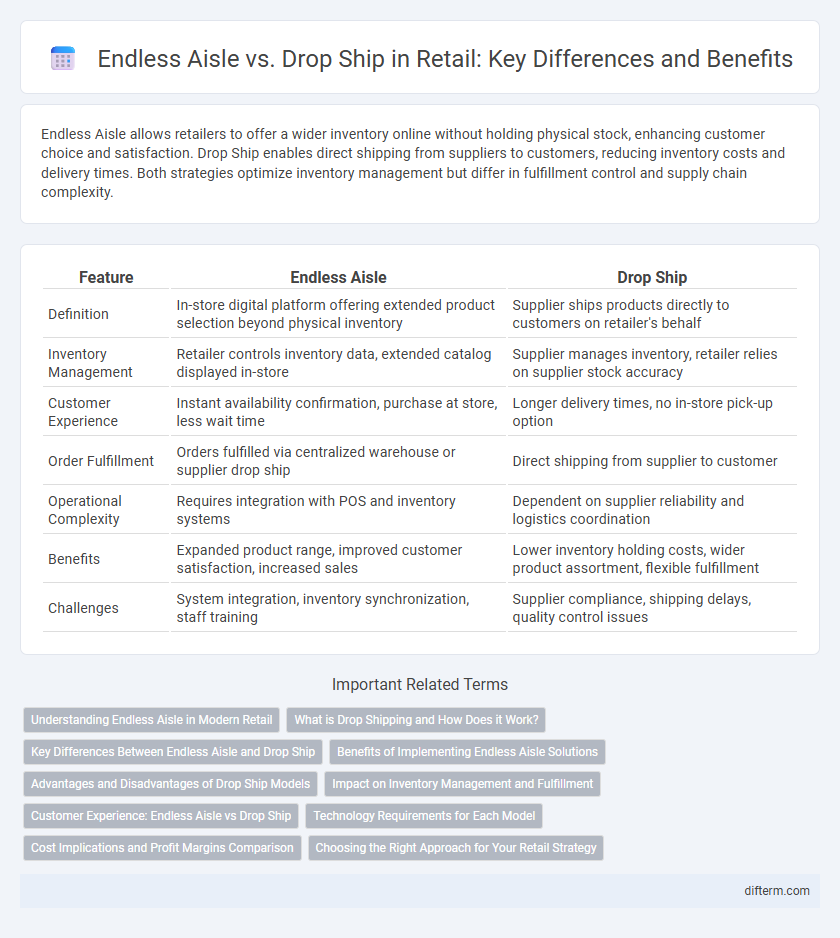Endless Aisle allows retailers to offer a wider inventory online without holding physical stock, enhancing customer choice and satisfaction. Drop Ship enables direct shipping from suppliers to customers, reducing inventory costs and delivery times. Both strategies optimize inventory management but differ in fulfillment control and supply chain complexity.
Table of Comparison
| Feature | Endless Aisle | Drop Ship |
|---|---|---|
| Definition | In-store digital platform offering extended product selection beyond physical inventory | Supplier ships products directly to customers on retailer's behalf |
| Inventory Management | Retailer controls inventory data, extended catalog displayed in-store | Supplier manages inventory, retailer relies on supplier stock accuracy |
| Customer Experience | Instant availability confirmation, purchase at store, less wait time | Longer delivery times, no in-store pick-up option |
| Order Fulfillment | Orders fulfilled via centralized warehouse or supplier drop ship | Direct shipping from supplier to customer |
| Operational Complexity | Requires integration with POS and inventory systems | Dependent on supplier reliability and logistics coordination |
| Benefits | Expanded product range, improved customer satisfaction, increased sales | Lower inventory holding costs, wider product assortment, flexible fulfillment |
| Challenges | System integration, inventory synchronization, staff training | Supplier compliance, shipping delays, quality control issues |
Understanding Endless Aisle in Modern Retail
Endless Aisle in modern retail leverages digital technology to offer customers access to a vast inventory beyond the physical store's limitations, enhancing product variety without increased shelf space. This strategy improves customer satisfaction by enabling instant browsing and ordering of out-of-stock or non-displayed items directly from the retailer's warehouse or supplier inventory. Retailers integrating Endless Aisle solutions benefit from increased sales opportunities and reduced lost sales, contrasting with Drop Ship models that depend heavily on third-party suppliers for fulfillment.
What is Drop Shipping and How Does it Work?
Drop shipping is a retail fulfillment method where the store does not keep products in stock but instead transfers customer orders and shipment details to a third-party supplier, who then ships the products directly to the customer. This approach reduces inventory costs and minimizes the risks associated with overstocking. Retailers benefit from a drop shipping model by expanding product offerings without the need for warehousing or upfront inventory investment.
Key Differences Between Endless Aisle and Drop Ship
Endless Aisle allows retailers to offer customers access to a broader range of products in-store by digitally extending inventory without physically stocking items, improving customer experience and sales potential. Drop Ship involves shipping products directly from suppliers to customers, reducing the need for inventory holding and minimizing fulfillment costs. The key difference lies in Endless Aisle enhancing in-store offerings through digital channels, while Drop Ship streamlines fulfillment by bypassing traditional inventory storage.
Benefits of Implementing Endless Aisle Solutions
Endless Aisle solutions expand product availability beyond store inventory, enabling retailers to offer a wider selection without increasing physical stock. This technology enhances customer satisfaction by providing real-time access to online inventory, reducing out-of-stock scenarios and improving conversion rates. Retailers benefit from increased sales opportunities and optimized inventory management while delivering a seamless omnichannel shopping experience.
Advantages and Disadvantages of Drop Ship Models
The drop ship model enables retailers to offer a vast product assortment without holding inventory, reducing upfront costs and minimizing storage risks. However, this approach may lead to longer shipping times, less control over product quality, and potential discrepancies in inventory availability. Retailers must balance the benefits of expanded offerings with challenges in supply chain management and customer satisfaction.
Impact on Inventory Management and Fulfillment
Endless Aisle enables retailers to showcase a broader product assortment without holding physical inventory, streamlining inventory management by reducing overstock risk and improving fulfillment speed through seamless integration with supplier networks. Drop Ship shifts fulfillment responsibility directly to suppliers, minimizing inventory costs for retailers but increasing complexity in inventory visibility and demand forecasting. Both strategies enhance inventory efficiency but require robust real-time data exchange and coordination between retailers and suppliers to optimize order accuracy and delivery timelines.
Customer Experience: Endless Aisle vs Drop Ship
Endless Aisle enhances customer experience by providing immediate product availability in-store, allowing customers to browse and order items not physically present, which reduces wait times and increases satisfaction. Drop Ship offers a broader inventory range shipped directly from suppliers to customers, expanding product variety but often resulting in longer delivery times and potential communication challenges. Balancing the convenience and instant gratification of Endless Aisle with the extensive selection of Drop Ship strategies is crucial for retailers aiming to optimize customer engagement and loyalty.
Technology Requirements for Each Model
Endless Aisle technology requires robust real-time inventory management systems, integrated point-of-sale (POS) platforms, and seamless connectivity between brick-and-mortar stores and central warehouses to enable immediate customer access to extended product catalogs. Drop Ship model demands advanced supplier integration capabilities, automated order routing, and comprehensive tracking systems to efficiently manage third-party logistics and fulfillment processes. Both models rely heavily on scalable cloud infrastructure and APIs to ensure synchronization of product availability, pricing, and delivery updates across multiple sales channels.
Cost Implications and Profit Margins Comparison
Endless Aisle minimizes upfront inventory costs by enabling retailers to showcase a wider product range without holding stock, improving cash flow and reducing warehousing expenses. Drop Ship shifts fulfillment burdens to suppliers, which lowers inventory risk but increases per-unit costs, squeezing profit margins due to fees and shipping expenses. Retailers must balance Endless Aisle's cost-efficient inventory model with Drop Ship's higher operational fees to optimize overall profitability.
Choosing the Right Approach for Your Retail Strategy
Endless Aisle enables retailers to offer an expanded product assortment by integrating online inventory with in-store displays, enhancing customer experience without increasing physical stock. Drop Ship reduces inventory risk by having suppliers ship products directly to customers, streamlining fulfillment but potentially extending delivery times. Selecting between Endless Aisle and Drop Ship depends on factors such as inventory control preferences, delivery speed priorities, and the desired customer engagement level within the retail strategy.
Endless Aisle vs Drop Ship Infographic

 difterm.com
difterm.com